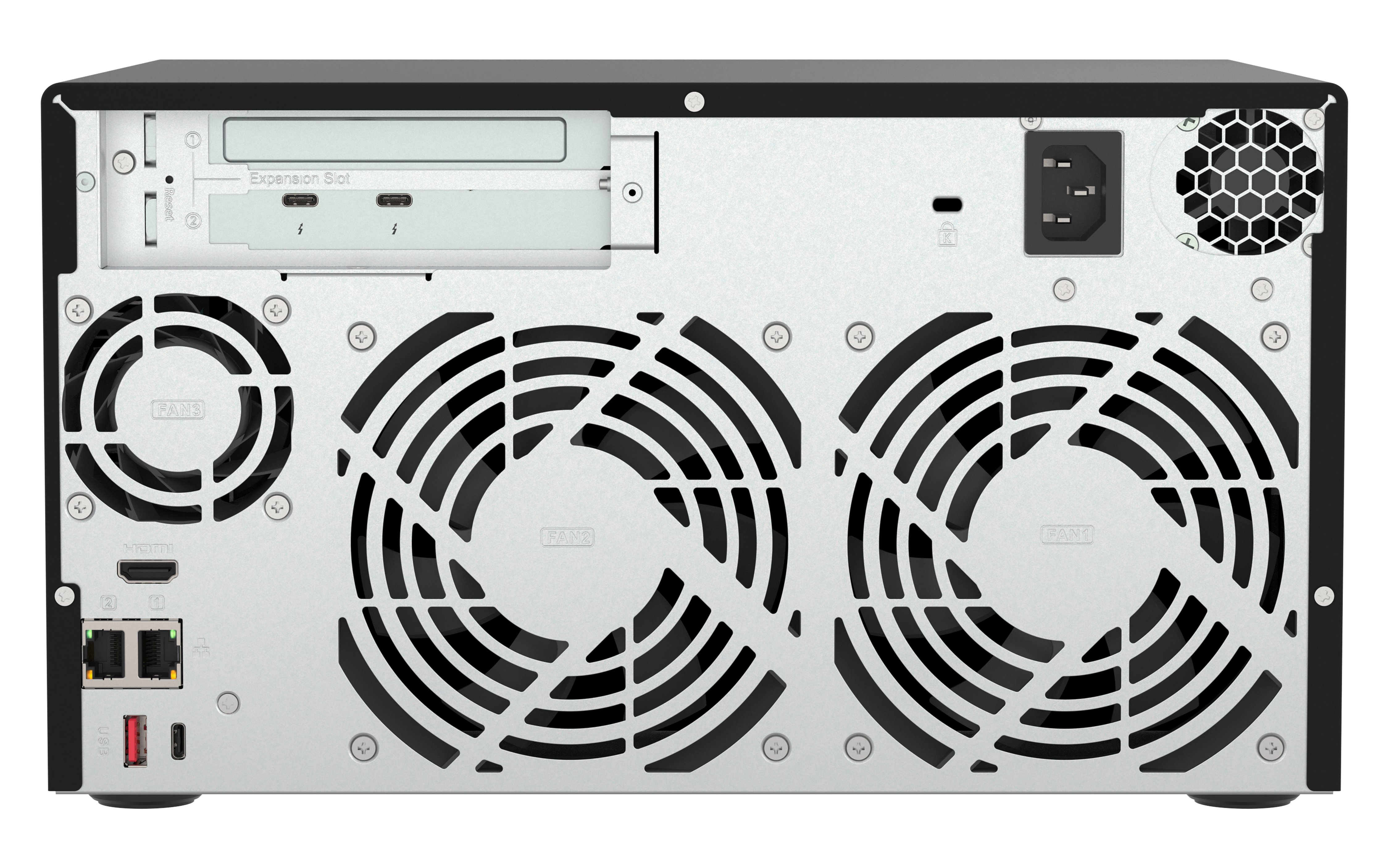Qnap TVS-h874T review: The Thunderbolt 4 NAS you need
This powerful desktop NAS appliance and its high-speed Thunderbolt 4 ports will appeal to video editors

-
+
Dual TB4 ports
-
+
Powerful Core i7 CPU
-
+
Great 10GbE performance
-
+
Feature-rich QuTS hero software
-
-
Pricey, Expansion slots tricky to access

READ MORE

Content creators seeking a powerful storage system for their video masterpieces may find Qnap's TVS-h874T could be just the ticket. Proudly claimed by Qnap as the world's first Thunderbolt 4 NAS, this 8-bay desktop box sports a pair of these 40Gbits/sec ports for those who want fast access for 4K video production.
There's plenty of power to hand as Qnap offers a choice of Intel's Gen12 Core i7 or Core i9 CPUs. We have the cheaper option on review which sports a 12-core Core i7-12700E CPU offering eight 2.1GHz Performance cores, four 1.6GHz Efficient cores, and an integrated Intel UHD Graphics 770 GPU.
The appliance comes with 32GB of DDR4 memory upgradeable to 64GB – an important feature as the 'h' in the model name indicates Qnap is aiming this NAS primarily at its QuTS hero OS. This is more demanding than Qnap's QTS as it requires at least 16GB for its inline data deduplication feature and 32GB to get the best performance from 10GbE upgrades.
Qnap TVS-h874T review: Hardware features
The appliance is encased in a sturdy steel chassis with solid plastic lockable tool-free drive carriers and removing the metal lid reveals a tidy interior with Qnap's QXP-T42P Thunderbolt 4 card fitted in the lower of the two PCIe slots. Space is limited here as accessing the upper X16 slot requires an L-shaped screwdriver, otherwise the power supply will have to be removed to gain access to its bracket screw.
The motherboard sits in the right side of the chassis with the CPU fitted with a large finned passive heatsink and partnered by a small cooling fan further back. General chassis cooling is handled by two 12cms diameter rear fans and during testing, we were impressed with how quiet the appliance was making it a great choice for small offices and home workers.

The 32GB of base memory is supplied as two 16GB DDR4 SO-DIMM modules so any upgrades will require one or both of them to be replaced and for reasons that escape us, Qnap has placed warranty stickers over the edge of each stick stating it will be voided if they are removed. Below the memory modules is a pair of easily accessible M.2 2280 NVMe SSD slots and these are the PCIe Gen 4 variety.
Qnap TVS-h874T review: 10GbE NAS and IP SAN performance
We fitted a pair of Kingston 480GB M.2 NVMe SSDs and after following the web console's wizard to install QuTS hero, we used them as a mirrored array for the initial system pool. For general data storage, we fitted a quartet of 22TB Western Digital Red Pro NAS drives and used the Storage & Snapshots app to create a big 58TB RAID5 pool.
Sign up today and you will receive a free copy of our Future Focus 2025 report - the leading guidance on AI, cybersecurity and other IT challenges as per 700+ senior executives
For our 10GbE performance tests, we installed a dual-port 10GbE SFP+ fibre adapter in the appliance and called up the lab's HPE ProLiant DL380 Gen11 rack server for host duties. This was equipped with dual 32-core 2.1GHz Xeon Scalable Gold 6430 CPUs, 256GB of DDR5 memory plus a dual-port 10GbE SFP+ adapter and running Windows Server 2022.
With a NAS share on the RAID5 array mapped over 10GbE to the server, we recorded top Iometer sequential read and write rates of 9.3 and 9.2Gbits/sec, and swapping over to random operations returned very similar results. These numbers highlight an important feature of QuTS hero as its ZFS file system's ARC (adaptive read cache) and ZIL (ZFS intent log) features are already very efficient making SSD caches unnecessary.
RELATED RESOURCE

Discover a data lakehouse solution that provides a modern data foundation to scale AI
Moving over to IP SANs delivered equally impressive results with a 1TB target recording high sequential and random read and write rates of between 9.3Gbits/sec and 9.1Gbits/sec. We ramped up the pressure with a dual-10GbE MPIO link to the target and watched Iometer sequential and random read rates increase to 18.2Gbits/sec and 17.8Gbits/sec with write operations settling at 18Gbits/sec and 17.7Gbits/sec respectively.
I/O throughput for the MPIO iSCSI connection was also excellent. Dropping to Iometer 4KB block sizes delivered sequential read and write rates of 210,700 and 206,800 IOPS and changing to random operations saw read and write throughputs of 202,300 and 162,600 IOPS. We noted during all our tests that the QuTS resource monitor showed CPU utilization never going above 12 per cent so we can't see it having any problems delivering Thunderbolt 4 speeds
Qnap TVS-h874T review: QuTS hero features
QuTS hero offers superior data protection features to QTS with its ZFS copy-on-write delivering near unlimited NAS and iSCSI LUN snapshots along with inline data deduplication and compression. End-to-end checksums handle self-healing of data corruption while the SnapSync app provides fast snapshot backups to remote QuTS appliances using block-level replication run to a schedule or in real-time.

Along with the standard RAID arrays, you can also opt for triple parity RAID to protect against three drive failures or triple mirroring which stores identical copies of data on three drives. A choice of two WORM (write once read many) policies can also be applied to NAS shares during creation to protect their data from tampering or accidental deletion.
App choices for both OSes are equally impressive and include key backup utilities such as Hybrid Backup Sync (HBS) 3 which helps create a 3-2-1 appliance protection strategy and now supports the new myQNAPcloud hosted storage. Virtualization is on the menu with the Container Station, Ubuntu Linux Station, and Virtualization Station apps all present while Hyper Data Protector keeps your VMware and Hyper-V VMs safe by backing them up regularly.
Qnap TVS-h874T review: Is it worth it?
With the model on review costing around £2,700 excluding VAT, the TVS-h874T represents a considerable investment but its powerful Core i7-12700E CPU provides a good return as performance is extremely good. The appliance's high memory capacity makes it a perfect platform for Qnap's QuTS hero OS which offers a wealth of enterprise-class data protection features and it's a good choice for video editors that want super-fast Thunderbolt 4 ports and plenty of storage potential.
Qnap TVS-h874T specifications
| Chassis | Desktop chassis |
| CPU | 2.1GHz 12-core Intel Core i7-12700E |
| Memory | 32GB DDR4 SODIMM (max 64GB) |
| Storage | 8 x SATA LFF/SFF, 2 x M.2 2280 PCIe 4 NVMe SSD slots |
| RAID (QuTS) | RAID0, 1, 5, 6, 10, 50, 60, Triple Mirror, Triple Parity |
| Thunderbolt | Qnap QXP-T42P dual-port Thunderbolt 4 PCIe card |
| Expansion | 2 x PCIe Gen4 (1 free) |
| Network | 2 x 2.5GbE multi-Gigabit |
| Other ports | Type-C USB 3.2, 2 x Type-A USB 3.2, HDMI 1.4b |
| Power | 350W internal PSU |
| Management | Web browser |
| Warranty | 3 year limited |
Dave is an IT consultant and freelance journalist specialising in hands-on reviews of computer networking products covering all market sectors from small businesses to enterprises. Founder of Binary Testing Ltd – the UK’s premier independent network testing laboratory - Dave has over 45 years of experience in the IT industry.
Dave has produced many thousands of in-depth business networking product reviews from his lab which have been reproduced globally. Writing for ITPro and its sister title, PC Pro, he covers all areas of business IT infrastructure, including servers, storage, network security, data protection, cloud, infrastructure and services.
-
 Cohesity deepens Google Cloud alliance in data sovereignty push
Cohesity deepens Google Cloud alliance in data sovereignty pushNews The pair’s expanded collaboration will focus on new integrations for AI, cybersecurity, and data protection
By Daniel Todd Published
-
 Cisco says Chinese hackers are exploiting an unpatched AsyncOS zero-day flaw – here's what we know so far
Cisco says Chinese hackers are exploiting an unpatched AsyncOS zero-day flaw – here's what we know so farNews The zero-day vulnerability affects Cisco's Secure Email Gateway and Secure Email and Web Manager appliances – here's what we know so far.
By Emma Woollacott Published
-
 EU lawmakers want to limit the use of ‘algorithmic management’ systems at work
EU lawmakers want to limit the use of ‘algorithmic management’ systems at workNews All workplace decisions should have human oversight and be transparent, fair, and safe, MEPs insist
By Emma Woollacott Published
